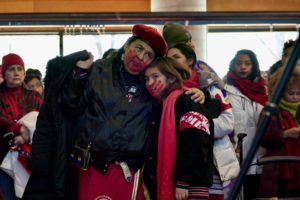The Indigenous Cultures Institute is putting new pressure on UT.
Update: 3:30 p.m., September 14: This story has been updated with a statement and comments provided by the University of Texas at Austin after initial publication and an earlier request for comment. – Warren Brown, deputy editor
In 2016, the Miakan-Garza Band, a Central Texas Indigenous group, requested the return of three sets of ancestral remains housed at the Texas Archeological Research Laboratory (TARL) at the University of Texas at Austin for reburial. Under Native American Graves Protection and Repatriation Act (NAGPRA) law, federally funded institutions are required to transfer Native American human remains and cultural items to claimants. For more than 30 years, the Miakan-Garza Band has fought for and eventually reburied remains of its ancestors in repatriation ceremonies.
It took about four years, but in 2020, some hope glimmered for the group, which has reburied 300 sets of remains in its four decades of existence. That fall, after another denial earlier in the year, it appeared that the university was prepared to comply with the group’s request.
Since then, Emi Aguilar, a Coahuiltecan arts educator who serves in the leadership circle as a culture and communications pīlam for the Indigenous Cultures Institute says it has been radio silence, except for TARL reaching out once to inform them that one of the three sets isn’t Native American remains.
“There’s no pressure put on public entities to actually return the remains,” Aguilar says. “And so they can literally just exhaust this for the end of time.”
A timeline provided by UT to MySA after this story’s initial publication contradicts Aguilar’s assertion that the university failed to reach out. It says that in spring 2021, new TARL Director Fred Valdez met with the Miakan-Garza Band and multiple stakeholders to discuss a plan of dispersal of all remains at the laboratory, including the three requested by the Band. “Miakan-Garza Band expresses support for Fred Valdez’s plan and indicates understanding that implementing plan will take time,” the document reads. The timeline also has an entry for August 21, 2022, mentioning that Valdez updated the Miakan-Garza Band of the status of its request.
Aguilar believes that the university is stalling, hoping the group gets frustrated and forgets about the ordeal.
“Or die,” she says. “Our elders are old, and have been working on having their ancestors returned for their entire lives. They’re just waiting for us to go away.”
But in mid-August, the Miakan-Garza Band re-upped its efforts.
On Wednesday, September 14, the Indigenous Cultures Institute, founded by members of the Miakan-Garza Band in 2006, will hold a pilgrimage and prayer circle. From 4 to 6 p.m., beginning at the Winship Drama Building at 23rd Street, members and supporters will be peacefully protesting the return of three sets of remains to the Miakan-Garza Band. From Winship, the group will walk to the UT Tower, many people holding cardboard boxes to symbolize the — for now — final resting places of the Indigenous remains.
The journey has been a fraught one, and the event on Wednesday marks almost two years since UT Austin President Jay Hartzell wrote a letter to founder Mario Garza of the Indigenous Cultures Institute, pledging to “promptly seek authority from the National Park Service to allow the remains identified in your letter to be reinterred” on September 25, 2020. Hartzell’s letter, dated on the third day of his tenure as official president of UT Austin — he had been interim president since that April — goes on to outline a plan request a recommendation from the NAGPRA Review Committee to “offer the remains promptly for reburial.”
After publication, UT Austin provided a statement to MySA.
“Since 2016, TARL has worked diligently and within legal requirements to respond to a request to transfer sets of human remains to the Miakan-Garza Band. On multiple occasions, TARL has found insufficient grounds for repatriation, as well as opposition from two federally recognized tribes. TARL has since proposed an alternative process for reburial of the remains and has sought guidance from the NAGPRA Office on implementation. In March 2022, the NAGPRA Office directed TARL to place repatriation and transfer efforts on hold while the alternative plan is explored. TARL does not have the authority to override this directive or transfer the remains to Miakan-Garza Band without NAGPRA approval. TARL remains committed to working with the Miakan-Garza Band to arrive at a proper solution.”

The repatriation is complicated by the approach to those very recommendations. According to university literature, UT confirms that the remains that the Miakan-Garza Band requests are “undisputedly those of pre-historic Native Americans,” but mentions that TARL cannot determine if they are Coahuiltecan, the state-recognized tribe to which the Band belongs. It also says that two other tribes “with geographic ties to the region where the remains were found objected to the repatriation.” The latter point is one to which Aguilar and the Miakan-Garza band pointedly objects.
“It’s entirely irrelevant,” Aguilar says. “It doesn’t matter if another tribe protests. It’s not relevant to the law.”
NAGPRA law states that “if there is more than one (1) claimant, the human remains, funerary object, sacred object, or objects of cultural patrimony may be held by the responsible museum or Federal agency or person in possession thereof pending resolution of the claim.” If two other tribes were placing claim on the remains held at TARL, then UT would be allowed to keep possession of the remains for the time being. But Aguilar says that the way UT’s statement is written doesn’t tell the full story, that neither of the other tribes in question have made an actual claim on the remains.
“Those two tribes don’t have a claim,” Aguilar says. “They don’t want the remains, they just don’t want us to get them.”

Wednesday’s event has some precedent; three weeks before Hartzell reversed his 2020 decision, the group held a teach-in and demonstration at the J.J. Pickle Research Campus, the northwest Austin location that houses the TARL and more than 2,400 sets of Indigenous remains. After Hartzell’s letter arrived, Aguilar says the group felt “so much hope,” but were apprehensive about the repatriation coming to fruition.
In the interim — and beginning before the UT claim in 2016 — the Miakan-Garza Band has found a more willing partner in Texas State University. On March 27, the Miakan-Garza Band buried four ancestors in San Marcos, bringing the number repatriated from Texas State up to 11. The remains are reinterred at a burial site established by the City of San Marcos behind a wrought iron fence donated by Texas State.
“They understand the sacredness of that site that their university occupies,” Aguilar says. “[UT] could learn from, not only Texas State, but other movements around the country — being good stewards and tapping into that moral conscience.”




